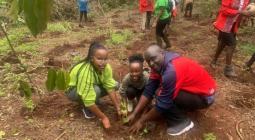Seven times size of Manhattan: the African tree-planting project making a difference
Thousands of farmers have been persuaded by TREES scheme to replace barren monocultures with biodiverse forest gardens
In a world of monoculture cash crops, an innovative African project is persuading farmers to plant biodiverse forest gardens that feed the family, protect the soil and expand tree cover.
Could Trees for the Future (TREES) be a rare example of a mass reforestation campaign that actually works? The United Nations Environment Programme (UNEP) certainly thinks so and last month awarded it the status of World Restoration Flagship.
Since it was founded in 2015, the programme has planted tens of millions of trees each year in nine countries ranging from Senegal and Mali to Tanzania and Kenya. In less than 10 years, it has reportedly restored a combined area of more than 41,000 hectares, which is about seven times the size of Manhattan.
This includes part of the African Union’s Great Green Wall initiative, a planned 8,000km-wide barrier of vegetation to hold back the deserts that are encroaching across the Sahel region. Organisers say this will be the largest natural structure on the planet, though it is still very much a work in progress.
Trees for the Future has ambitious plans to use reforestation to combat poverty. By 2030, it aims to create 230,000 jobs and plant a billion trees.
A commitment to restoration is essential, according to Inger Andersen, executive director of UNEP, who noted it was no longer enough to merely protect what was left of Africa’s fertile land. This continent will be home to a quarter of the world’s population in little more than a generation and many areas have already degraded into semi-barren drylands.
“Initiatives like TREES are playing an important role in reversing decades of ecosystem degradation, especially across the Sahel, pushing back desertification, increasing climate resilience and improving the wellbeing of farmers and their communities,” Andersen said in announcing the World Restoration Flagship.
While there is no doubt about the need for reforestation, there are historical reasons to be sceptical about the effectiveness of such programmes. Expectations are often too high. A 2019 study suggesting the climate crisis could be significantly eased by planting a trillion trees across the world was later debunked as unrealistic because there was not enough suitable land.
Many governments have launched mass tree-planting campaigns, but after the initial day or two of publicity, there is rarely sufficient irrigation, protection and other follow-up to ensure seeds and saplings grow into trunks and branches. Often such national initiatives are little more than greenwashing distractions from far greater forest destruction elsewhere.
Kenya, for example, has launched numerous tree-planting initiatives in recent decades, including the Million Operation Gavisha in 1977, the Trees Campaign in 2006, the Greening Kenya Initiative in 2010 and the Accelerated National Tree Growing Campaign 2022, yet overall, it has lost 11% of its tree cover since 2000.
The situation has stabilised somewhat in the past two years under the current president, William Ruto, who has declared an annual tree-planting holiday and set a national target to plant 15bn trees and raise tree cover to 30% by 2032. But the gains could be short-lived because Ruto recently lifted the six-year logging ban to boost economic growth. This puts more pressure on Mau forest, which is already being cleared for tea and wheat fields; Migori forest, which is encroached upon by sugar producers; and Nyanza forest, which is an expanding area for tobacco farmers.
The protection of primary forests is a priority for the global climate, local biodiversity and regional water cycles. Those functions, built up over centuries, cannot be fully replaced by new plantations and restoration projects. But TREES and similar programmes can help to alleviate ecological and economic problems in already degraded areas.
At Kesouma, on the edge of Lake Victoria in western Kenya, organisers say they have supported 17,000 smallholder farmers with training, seeds, tools and grants to plant “forest gardens” instead of the monocultures that left their plots exposed and sucked dry of moisture, carbon and nutrients.
The area is subdivided into groups of 20 smallholders, represented by a lead farmer, who is paid a stipend of 3,000 Kenyan shillings every month. All members regularly meet for reporting, training and access to the tools and seed banks to nurture a forest garden. Individual plots, which cover 1 hectare on average, are said to have about 5,800 trees of multiple varieties.
On the outer perimeter there is a “protective wall” made up of three ranks of Acacia polyacantha (white thorn). Behind this is a cluster of tightly-spaced agroforestry trees that grow quickly and can be used for firewood and fodder. In the centre is a mix of vegetable gardens and orchards of mangoes, avocados, oranges, apples and other fruits. The aim is to provide sufficient nutrition to feed a family with a small surplus crop to sell at the market.
In one pilot area in the Lake Victoria basin, incomes are to be further bolstered by cash from carbon credits provided by the US firm Catona Climate based on gains in soil organic carbon, which is measured by experts from the University of Nairobi and Wangari Maathai Institute of Peace and Environmental Studies.
Monitoring is a key element in any reforestation programme, as is maintenance, particularly in remote areas. Major projects in China and Africa – including the Great Green Wall – have tried to address this by dropping seeds by plane in uninhabited areas. With species often unsuited to the terrain and irrigation impossible, this has often resulted in wasted efforts. In that regard, forest gardens seem more promising, though the scope is limited. Farmers usually live in or near their fields and have a financial incentive to ensure the quality of the soil and the healthy growth of a variety of trees.
Vincent Mainga, the Kenya director of TREES, said the project would expand rapidly now it has the endorsement of UNEP. “This is a massive restoration movement using regenerative agriculture,” he said. “This model is very easy to adopt. We work with the farmers for four years. After that, they can understand all the components and they can use what they learn from our technicians to produce thriving farmlands, usually with a surplus. It is self-sustaining.”
Cover photo: A Tanzania farmer taking part in the TREES project




